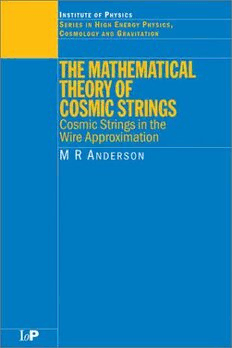Table Of ContentTHE MATHEMATICALTHEORY OFCOSMIC STRINGS
COSMICSTRINGSINTHEWIREAPPROXIMATION
Series inHighEnergy Physics,CosmologyandGravitation
Otherbooksintheseries
Electron–PositronPhysicsattheZ
MGGreen,SLLloyd,PNRatoffandDRWard
Non-acceleratorParticlePhysics
Paperbackedition
HVKlapdor-KleingrothausandAStaudt
IdeasandMethodsofSupersymmetryandSupergravity
orAWalkThroughSuperspace
Revisededition
ILBuchbinderandSMKuzenko
PulsarsasAstrophysicalLaboratoriesforNuclearandParticlePhysics
FWeber
ClassicalandQuantumBlackHoles
EditedbyPFre´,VGorini,GMagliandUMoschella
ParticleAstrophysics
Revisedpaperbackedition
HVKlapdor-KleingrothausandKZuber
TheWorldinElevenDimensions
Supergravity,SupermembranesandM-Theory
EditedbyMJDuff
GravitationalWaves
EditedbyICiufolini,VGorini,UMoschellaandPFre´
ModernCosmology
EditedbySBonometto,VGoriniandUMoschella
GeometryandPhysicsofBranes
EditedbyUBruzzo,VGoriniandUMoschella
TheGalacticBlackHole
LecturesonGeneralRelativityandAstrophysics
EditedbyHFalckeandFWHehl
THE MATHEMATICAL THEORY OF
COSMIC STRINGS
COSMIC STRINGSIN THEWIREAPPROXIMATION
Malcolm R Anderson
Departmentof Mathematics,
UniversitiBrunei,Darussalam
INSTITUTE OF PHYSICS PUBLISHING
BRISTOL AND PHILADELPHIA
c IOPPublishingLtd2003
(cid:1)
All rights reserved. No part of this publication may be reproduced, stored
in a retrieval system or transmitted in any form or by any means, electronic,
mechanical,photocopying,recordingorotherwise,withoutthepriorpermission
of the publisher. Multiple copying is permitted in accordance with the terms
of licences issued by the Copyright Licensing Agency under the terms of its
agreementwithUniversitiesUK(UUK).
BritishLibraryCataloguing-in-PublicationData
AcataloguerecordforthisbookisavailablefromtheBritishLibrary.
ISBN0750301600
LibraryofCongressCataloging-in-PublicationDataareavailable
CommissioningEditor:JamesRevill
ProductionEditor:SimonLaurenson
ProductionControl:SarahPlenty
CoverDesign:VictoriaLeBillon
Marketing:NicolaNeweyandVerityCooke
Published by Institute of Physics Publishing, wholly owned by The Institute of
Physics,London
InstituteofPhysicsPublishing,DiracHouse,TempleBack,BristolBS16BE,UK
US Office: Institute of Physics Publishing, The Public Ledger Building, Suite
929,150SouthIndependenceMallWest,Philadelphia,PA19106,USA
TypesetinLATEX2 byText2Text,Torquay,Devon
PrintedintheUK(cid:1)byMPGBooksLtd,Bodmin,Cornwall
Contents
Introduction ix
1 Cosmicstringsandbrokengaugesymmetries 1
1.1 Electromagnetismasalocalgaugetheory 3
1.2 Electroweakunification 8
1.3 TheNielsen–Olesenvortexstring 15
1.4 StringsasrelicsoftheBigBang 24
1.5 TheNambuaction 27
2 Theelementsofstringdynamics 35
2.1 Describingazero-thicknesscosmicstring 35
2.2 Theequationofmotion 38
2.3 Gaugeconditions,periodicityandcausalstructure 41
2.4 Conservationlawsinsymmetricspacetimes 44
2.5 Invariantlength 48
2.6 Cuspsandcurvaturesingularities 49
2.7 Intercommutingandkinks 54
3 Stringdynamicsinflatspace 59
3.1 Thealignedstandardgauge 59
3.2 TheGGRTgauge 61
3.3 Conservationlawsinflatspace 63
3.4 Initial-valueformulationforastringloop 68
3.5 Periodicsolutionsinthespinorrepresentation 70
3.6 TheKibble–Turoksphereandcuspsandkinksinflatspace 73
3.7 Fieldreconnectionatacusp 80
3.8 Self-intersectionofastringloop 85
3.9 Secularevolutionofastringloop 92
4 Abestiaryofexactsolutions 99
4.1 Infinitestrings 99
4.1.1 Theinfinitestraightstring 99
4.1.2 Travelling-wavesolutions 100
4.1.3 Stringswithpairedkinks 102
4.1.4 Helicalstrings 103
vi Contents
4.2 Somesimpleplanarloops 105
4.2.1 Thecollapsingcircularloop 105
4.2.2 Thedoubledrotatingrod 106
4.2.3 Thedegeneratekinkedcusplessloop 107
4.2.4 Cat’s-eyestrings 108
4.3 Balloonstrings 112
4.4 Harmonicloopsolutions 114
4.4.1 Loopswithoneharmonic 114
4.4.2 Loopswithtwounmixedharmonics 117
4.4.3 Loopswithtwomixedharmonics 122
4.4.4 Loopswiththreeormoreharmonics 127
4.5 Stationaryrotatingsolutions 130
4.6 Threetoysolutions 135
4.6.1 Theteardropstring 135
4.6.2 Thecardioidstring 137
4.6.3 Thefigure-of-eightstring 141
5 Stringdynamicsinnon-flatbackgrounds 144
5.1 StringsinRobertson–Walkerspacetimes 144
5.1.1 Straightstringsolutions 145
5.1.2 Ringsolutions 147
5.2 StringsnearaSchwarzschildblackhole 152
5.2.1 Ringsolutions 153
5.2.2 Staticequilibriumsolutions 157
5.3 ScatteringandcaptureofastraightstringbyaSchwarzschildhole 159
5.4 RingsolutionsintheKerrmetric 167
5.5 StaticequilibriumconfigurationsintheKerrmetric 170
5.6 Stringsinplane-fronted-wavespacetimes 177
6 Cosmicstringsintheweak-fieldapproximation 181
6.1 Theweak-fieldformalism 182
6.2 Cuspsintheweak-fieldapproximation 185
6.3 Kinksintheweak-fieldapproximation 189
6.4 Radiationofgravitationalenergyfromaloop 191
6.5 Calculationsofradiatedpower 196
6.5.1 Powerfromcusplessloops 197
6.5.2 PowerfromtheVachaspati–Vilenkinloops 199
6.5.3 Powerfromthe p/q harmonicsolutions 202
6.6 Powerradiatedbyahelicalstring 204
6.7 Radiationfromlongstrings 208
6.8 Radiationoflinearandangularmomentum 211
6.8.1 Linearmomentum 211
6.8.2 Angularmomentum 213
6.9 Radiativeefficienciesfrompiecewise-linearloops 219
6.9.1 Thepiecewise-linearapproximation 219
Contents vii
6.9.2 Aminimumradiativeefficiency? 223
6.10 Thefieldofacollapsingcircularloop 226
6.11 Theback-reactionproblem 231
6.11.1 Generalfeaturesoftheproblem 231
6.11.2 Self-accelerationofacosmicstring 234
6.11.3 Back-reactionandcuspdisplacement 240
6.11.4 Numericalresults 242
7 Thegravitationalfieldofaninfinitestraightstring 246
7.1 Themetricduetoaninfinitestraightstring 246
7.2 Propertiesofthestraight-stringmetric 250
7.3 TheGeroch–Traschencritique 252
7.4 Isthestraight-stringmetricunstabletochangesintheequationof
state? 255
7.5 Adistributionaldescriptionofthestraight-stringmetric 259
7.6 Theself-forceonamassiveparticlenearastraightstring 263
7.7 Thestraight-stringmetricin‘asymptotically-flat’form 267
8 Multiplestraightstringsandclosedtimelikecurves 271
8.1 Straightstringsand2+1gravity 271
8.2 Boostsandrotationsofsystemsofstraightstrings 273
8.3 TheGottconstruction 274
8.4 Stringholonomyandclosedtimelikecurves 278
8.5 TheLetelier–Gal’tsovspacetime 282
9 Otherexactstringmetrics 286
9.1 Stringsandtravellingwaves 286
9.2 Stringsfromaxisymmetricspacetimes 291
9.2.1 StringsinaRobertson–Walkeruniverse 292
9.2.2 AstringthroughaSchwarzschildblackhole 297
9.2.3 Stringscoupledtoacosmologicalconstant 301
9.3 Stringsinradiatingcylindricalspacetimes 303
9.3.1 Thecylindricalformalism 303
9.3.2 Separablesolutions 305
9.3.3 Stringsincloseduniverses 307
9.3.4 Radiatingstringsfromaxisymmetricspacetimes 310
9.3.5 Einstein–Rosensolitonwaves 316
9.3.6 Two-modesolitonsolutions 321
9.4 Snappingcosmicstrings 324
9.4.1 Snappingstringsinflatspacetimes 324
9.4.2 Otherspacetimescontainingsnappingstrings 329
viii Contents
10 Strong-fieldeffectsofzero-thicknessstrings 332
10.1 Spatialgeometryoutsideastationaryloop 334
10.2 Black-holeformationfromacollapsingloop 340
10.3 Propertiesoftheneargravitationalfieldofacosmicstring 343
10.4 A3+1splitofthemetricnearacosmicstring 346
10.4.1 Generalformalism 346
10.4.2 Somesamplenear-fieldexpansions 349
10.4.3 Seriessolutionsofthenear-fieldvacuumEinstein
equations 352
10.4.4 Distributionalstress–energyoftheworldsheet 355
Bibliography 359
Index 367
Introduction
Theexistenceofcosmicstringswasfirstproposedin1976byTomKibble,who
drew on the theory of line vortices in superconductorsto predict the formation
of similar structures in the Universe at large as it expanded and cooled during
the earlyphasesofthe Big Bang. The criticalassumptionis thatthestrongand
electroweak forces were first isolated by a symmetry-breaking phase transition
which converted the energy of the Higgs field into the masses of fermions and
vector bosons. Under certain conditions, it is possible that some of the Higgs
field energy remained in thin tubes which stretched across the early Universe.
Thesearecosmicstrings.
Themassesanddimensionsofcosmicstringsarelargelydeterminedbythe
energyscaleatwhichtherelevantphasetransitionoccurred.Thegrandunification
(GUT)energyscaleisatpresentestimatedtobeabout1015GeV,whichindicates
thattheGUTphasetransitiontookplacesome10−37–10−35saftertheBigBang,
whenthetemperatureoftheUniversewasoftheorderof1028K.Thethicknessof
acosmicstringistypicallycomparabletotheComptonwavelengthofaparticle
with GUT mass or about 10−29 cm. This distance is so much smaller than the
length scales important to astrophysics and cosmology that cosmic strings are
usuallyidealizedtohavezerothickness.
The mass per unit length of such a string, conventionally denoted µ, is
proportionalto the square of the energyscale, and in the GUT case hasa value
of about 1021 g cm−1. There is no restriction on the length of a cosmic string,
although in the simplest theories a string can have no free ends and so must
either be infinite or form a closed loop. A GUT string long enough to cross
theobservableUniversewouldhaveamasswithinthehorizonofabout1016 M(cid:1),
whichisnogreaterthanthemassofalargeclusterofgalaxies.
Interest in cosmic strings intensified in 1980–81, when Yakov Zel’dovich
and Alexander Vilenkin independently showed that the density perturbations
generated in the protogalactic medium by GUT strings would have been large
enoughtoaccountfortheformationofgalaxies.Galaxyformationwasthen(and
remainsnow)oneofthemostvexingunsolvedproblemsfacingcosmologists.The
extremeisotropyofthemicrowavebackgroundindicatesthattheearlyUniverse
was very smooth. Yet structure has somehow developed on all scales from
the planets to clusters and superclusters of galaxies. Such structure cannot be
ix

